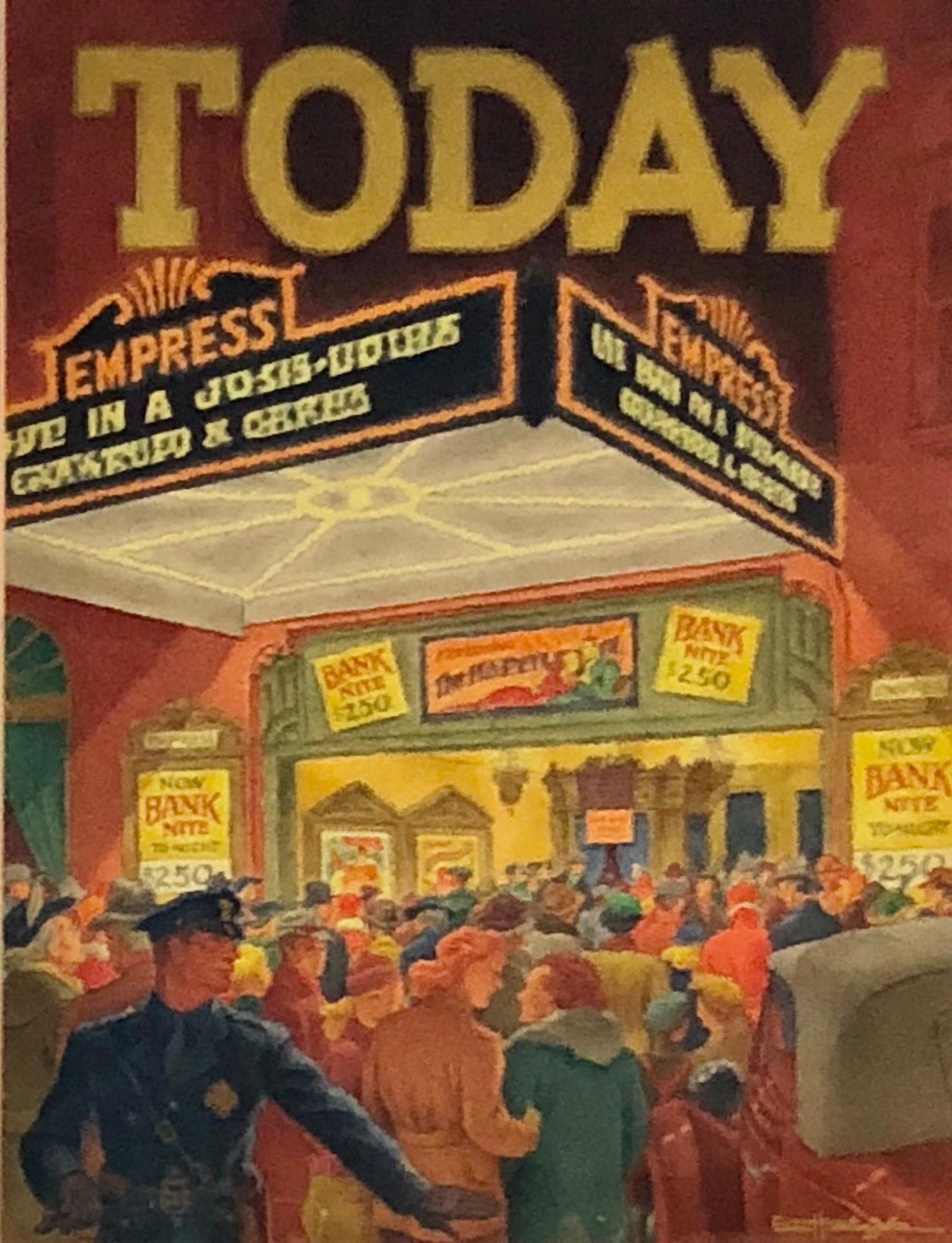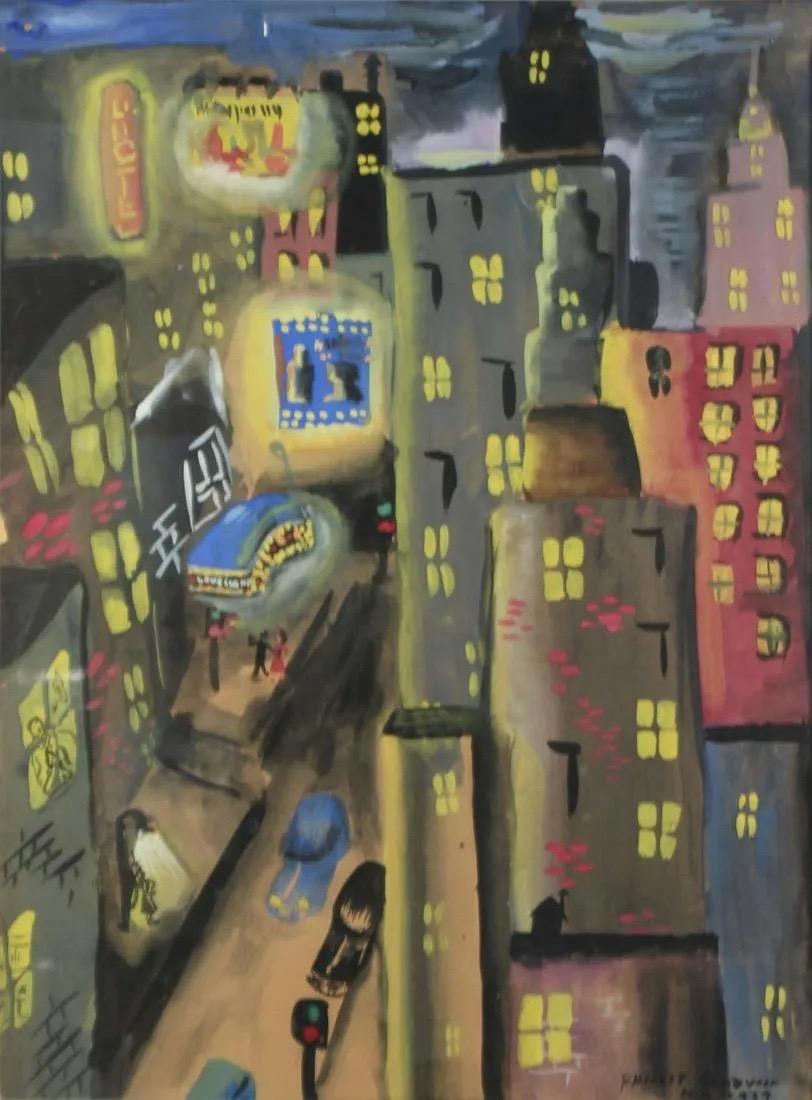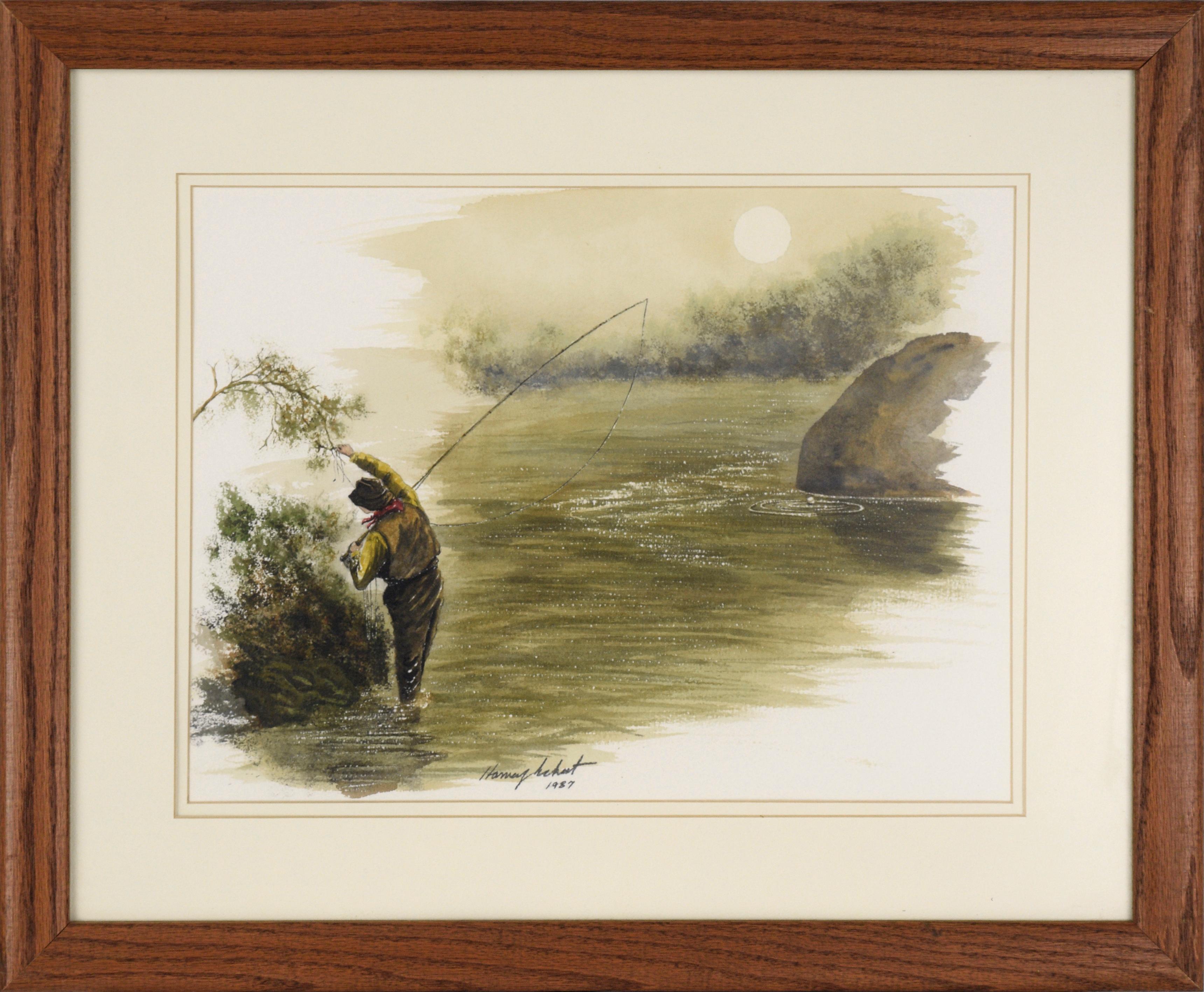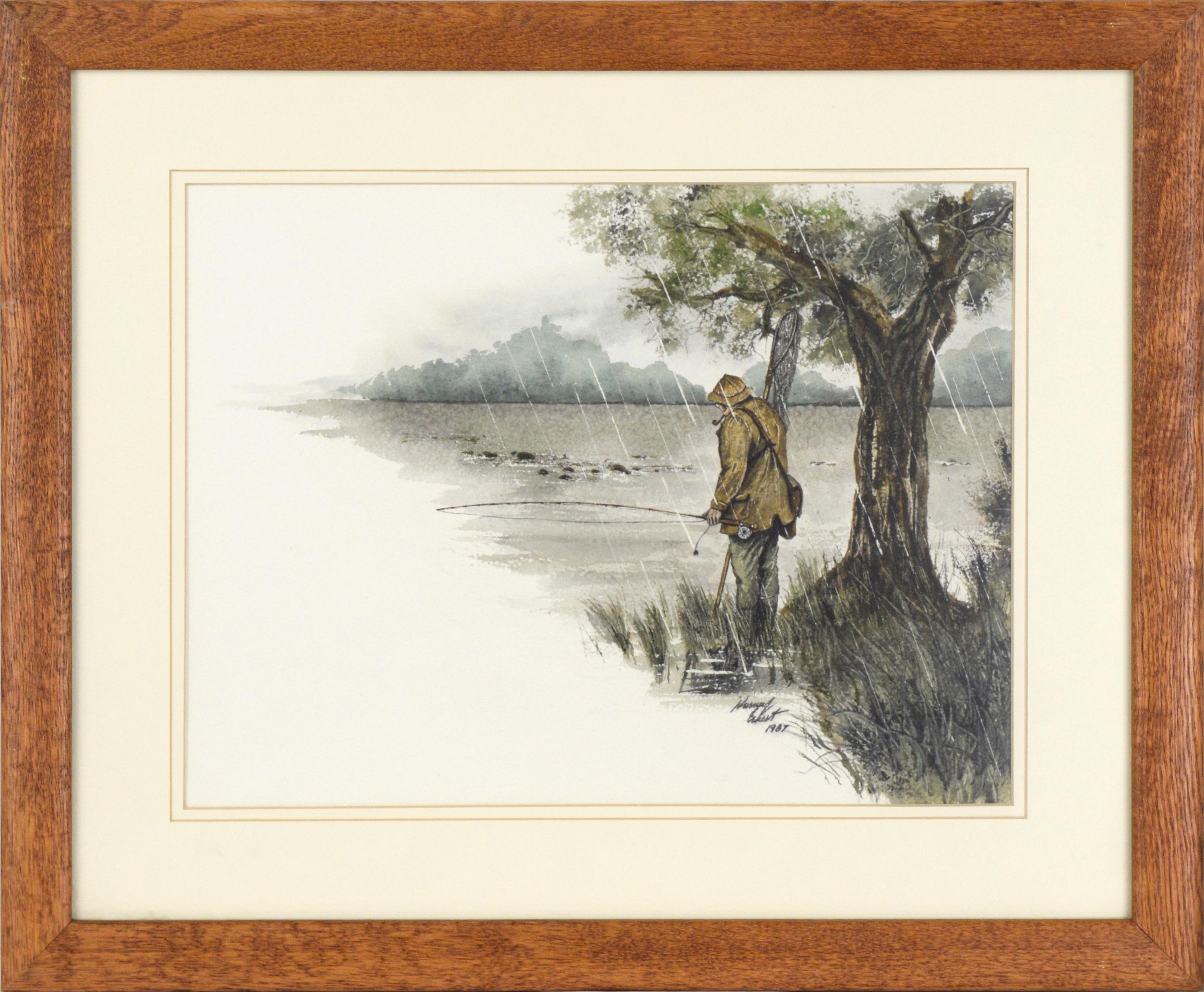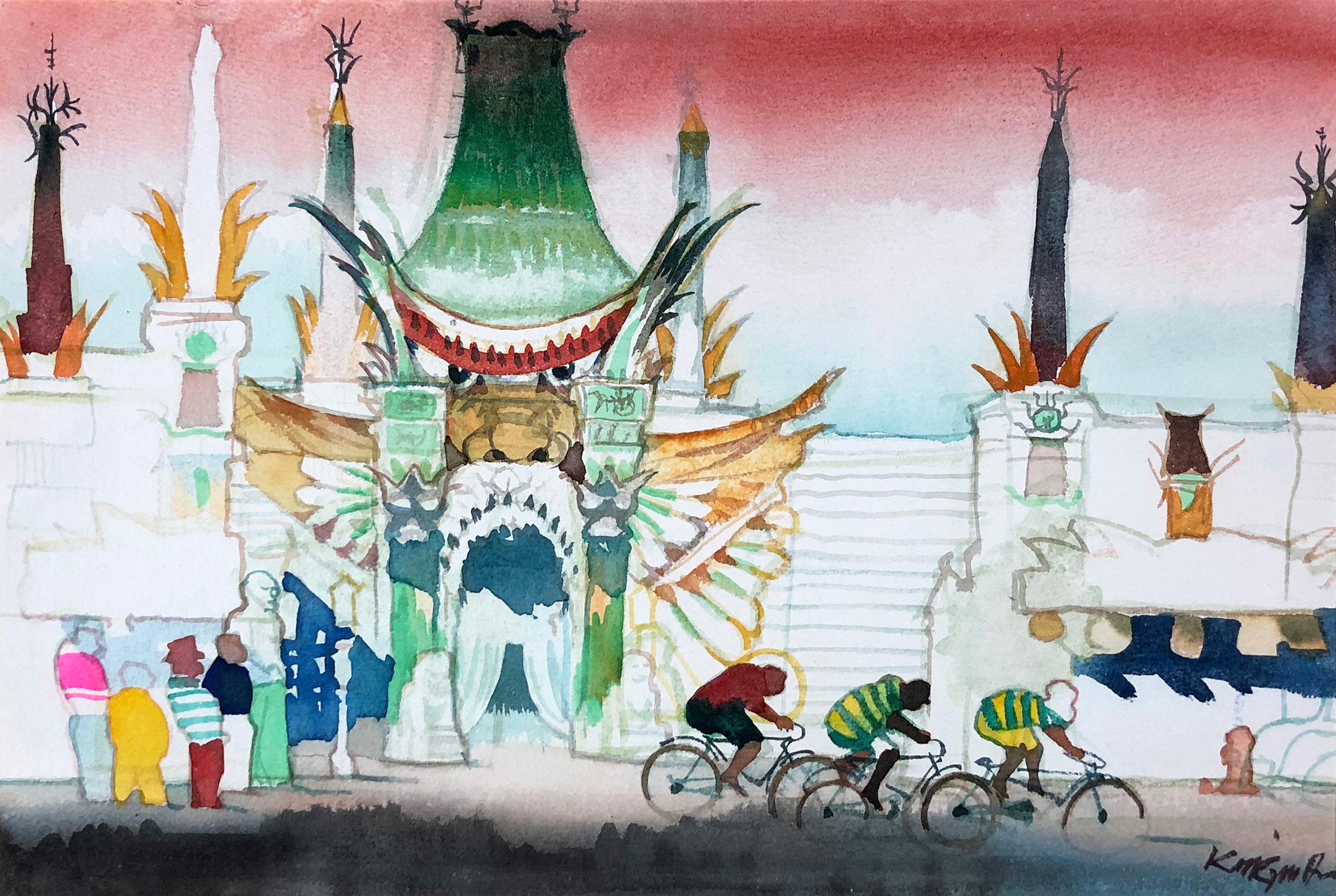Items Similar to African American Woman artist Mailou Jones Cezannian Cote d'Azur cubist village
Video Loading
Want more images or videos?
Request additional images or videos from the seller
1 of 11
Lois Mailou JonesAfrican American Woman artist Mailou Jones Cezannian Cote d'Azur cubist villageca 1953
ca 1953
About the Item
If you are interested in African American Art and in Women in the Arts, I will certainly not need to introduce Lois Mailou Jones (1905-1988). Often associated with the Harlem Renaissance, her
work can be found in the collections of the Smithsonian American Art Museum, The Metropolitan Museum of Art, the National Museum of Women in the Arts, the Brooklyn Museum, the Museum of Fine Arts, Boston, Muscarelle Museum of Art, and The Phillips Collection. I am proud to present an original watercolour painting by the artist which dates from the late 1940s or early 1950s.
Jones was born in Boston, Massachusetts to a father who became the first African-American to earn a law degree from Suffolk Law School. Jones's parents encouraged her to draw and paint using watercolors during her childhood. She held her first solo exhibition at the age of seventeen in Martha's Vineyard.
He career began in the 1930s and she continued to produce art work until her death in 1998 at the age of 92. Her style shifted and evolved multiple times in response to influences in her life, especially her extensive travels. She felt that her greatest contribution to the art world was "proof of the talent of black artists". Her work echoes her pride in her African roots and American ancestry.
In 1937, Jones received a fellowship to study in Paris at the Académie Julian, bringing her to France for the first time. The French were appreciative of her paintings and talent and Loïs Mailou Jones was thrilled at the country’s racial tolerance, so different from her reality in the United States.
She summered in France annually from 1945 to 1953, sharing studio with her lifelong friend Celine Marie Tabary in Cabris, France.
It was during one of these sojourns that the lovely work presented here was created.
Our painting depicts the village of Tourettes sur Loup, just north of Nice, in the Provence Cote d'Azur region, about 14 miles from Cabris.
Please note its similarities with her painting "Arreau, Hautes-Pyrénées" in the National Museum of Women in the Arts.
Her portrayal of the picturesque village nestled in a valley evokes landscape paintings by Paul Cézanne, a stylistic influence she acknowledged.
Over the course of the following 10 years, Jones exhibited at the Phillips Collection, Seattle Art Museum, National Academy of Design, the Barnett-Aden Gallery, Pennsylvania's Lincoln University, Howard University, galleries in New York, and the Corcoran Gallery of Art. In 1952, the book Loïs Mailou Jones: Peintures 1937–1951 was published, reproducing more than one hundred of her art pieces completed in France.At the Barnett-Aden Gallery, Jones exhibited with a group of prominent black artists, such as Jacob Lawrence and Alma Thomas. These artists and others were known as the "Little Paris Group.
Our watercolour/gouache painting on heavy paper is signed and situated at the lower right. It also bears an (exhibition?) number "2" and, interestingly, its original price, 15.000 French francs. It is presented in a limed wood late art deco frame. The size of the artwork visible under the mount with its frame is
For security and to avoid breakage/damage, the painting will be shipped unglazed.
- Creator:Lois Mailou Jones (1905 - 1998, American)
- Creation Year:ca 1953
- Dimensions:Height: 29.93 in (76 cm)Width: 25.79 in (65.5 cm)Depth: 1.19 in (3 cm)
- Medium:
- Movement & Style:
- Period:
- Condition:Toning to paper, some light creases, kozo lined for support.
- Gallery Location:Norwich, GB
- Reference Number:1stDibs: LU991312696502
About the Seller
5.0
Gold Seller
These expertly vetted sellers are highly rated and consistently exceed customer expectations.
1stDibs seller since 2018
73 sales on 1stDibs
Typical response time: 1 hour
- ShippingRetrieving quote...Ships From: Paris, France
- Return PolicyA return for this item may be initiated within 3 days of delivery.
More From This SellerView All
- Village Scene, Cornwall England - 19th Century, Impressionist Landscape DrawingLocated in Norwich, GBA lovely and very fresh watercolour on paper by John Baragwanath KING (1864—1939) This village scene is signed lower left, and measures 25 x 38 cm. It is presented in its original frame - the framed is 39 x 51cm Born in Cornwall, the artist trained first as an engineer before turning to art, and exhibited in London, Manchester and Paris. He lived at 'Westbourne', St Austell...Category
Late 19th Century Impressionist Landscape Drawings and Watercolors
MaterialsPaper, Watercolor
- Academic master drawing: Allegorical Scene artist in Musée d'OrsayLocated in Norwich, GBA fascinating allegorical scene by French master Paul-Louis Delance (1848–1924), an artist known for the allegorical and history paintings. His grandfather was the Count Joseph van R...Category
1870s Academic Figurative Drawings and Watercolors
MaterialsCharcoal, Paper
- Big sky, clouds over the Seine River French Impressionist landscape paintingBy Gaston PrunierLocated in Norwich, GBA stunning sky and cloud study by Gaston Prunier. Originally from Le Havre, the sea port where the Seine empties into the English Channel, Prunier was c...Category
1890s French School Landscape Drawings and Watercolors
MaterialsWatercolor, Gouache, Laid Paper
- French 19th Century Romantic Period 1830s Paris Society Beauty PortraitBy Adele GrassetLocated in Norwich, GBA astounding portrait of a society beauty by Adele Grasset (active ca 1830-1850). With an open face and and lightly smiling lips, she is wearing a gown typical of the romantic period. Drawn in graphite and heightened with white, the drawing is dated 1836 As often with woman artists of the 18th and 19th century, there is little biographical information available on Adèle Grasset. We do know however, that she had studied with the highly prominent artist François Gérard (1770-1837) , known also as the Baron Gérard...Category
1830s Academic Portrait Drawings and Watercolors
MaterialsPaper, Charcoal, Gouache
- The Hypochondriac: French 19th Century Theatre Comedy drawingBy Paul Gavarni (Guillaume Sulpice Chevalier)Located in Norwich, GBA magnificent and sensitively treated line drawing in coloured ink, heightened with white. It depicts Argan, the hypochondriac from Molière's play of the same name. Dating from circa...Category
Mid-19th Century French School Figurative Drawings and Watercolors
MaterialsGouache, Paper, Ink
- GladiatorBy Rainer KüchenmeisterLocated in Norwich, GBAn exquisite watercolour and paint painting on paper by German resistance fighter and concentration camp survivor Rainer Küchenmeister (1926-2010)...Category
1970s Expressionist Abstract Drawings and Watercolors
MaterialsWatercolor
You May Also Like
- Magazine Cover Illustration Mid 20th Century Modern Theatre Broadway Realism WPABy Ernest Hamlin BakerLocated in New York, NYMagazine Cover Illustration Mid 20th Century Modern Theatre Broadway Realism WPA Ernest Hamlin Baker (1889 – 1975) “Today Magazine” Cover ...Category
1930s American Modern Figurative Drawings and Watercolors
MaterialsPaper, Ink, Watercolor, Gouache
- "Times Square" Mid 20th Century 1937 Modernism Broadway Drawing NYC CityscapeLocated in New York, NY"Times Square" Mid 20th Century 1937 Modernism Broadway Drawing NYC Cityscape Philip Goodwin (20th Century) "Times Square," 23 ½ x 17 ¼ inches. Gouache...Category
1930s American Modern Landscape Drawings and Watercolors
MaterialsPaper, Gouache
- California Impressionist Landscape Painting Framed 19th Century Rare PurpleLocated in Buffalo, NYAn original American impressionist figurative watercolor of a California coastline with trees.Category
Early 1900s American Modern Landscape Drawings and Watercolors
MaterialsPaper, Watercolor
- Untangling a Fly from the TreeBy Harvey EckertLocated in Soquel, CADelicate depiction of a fly fisherman by Harvey Eckert (American, 1946-2018). Signed in the lower right corner. Presented in a wood frame with a double mat and anti-glare glass. Image size: 14"H x 18"W Harvey Eckert (American, 1946-2018) was an American artist from Kansas. He attended Colby Community College, Hays Emporia State and graduated from Wichita University with two degrees. While living in Montana, he was employed by Bob Wards, Fran Johnson’s Sporting Goods and Cashell Engineers as a surveyor and draftsman. Eckert illustrated three books, Caddisflies by the late Gary LaFontaine, Montana Trout Flies and The Master Fly Weaver by the late George Grant. He did illustrations for the following publications: Montana Outdoors, Colorado Streamside, The River Rat published by Trout Unlimited, Fly Fisherman, Rod and Reel...Category
1980s American Modern Figurative Drawings and Watercolors
MaterialsPaper, Watercolor
- The Fly Fisherman, Figurative Landscape WatercolorBy Harvey EckertLocated in Soquel, CADelicate depiction of a fly fisherman in the rain by Harvey Eckert (American, 1946-2018). This highly detailed landscape watercolor depicts a man fishing in the rain, wading into the water as he smokes a pipe under a tree. Signed and dated in the lower right corner. Presented in a wood frame with a double mat and anti-glare glass. A check from the original purchase is attached to verso (blurred for privacy). Image size: 14"H x 18"W Harvey Eckert (American, 1946-2018) was an American artist from Kansas. He attended Colby Community College, Hays Emporia State and graduated from Wichita University with two degrees. While living in Montana, he was employed by Bob Wards, Fran Johnson’s Sporting Goods and Cashell Engineers as a surveyor and draftsman. Eckert illustrated three books, Caddisflies by the late Gary LaFontaine, Montana Trout Flies and The Master Fly Weaver by the late George Grant. He did illustrations for the following publications: Montana Outdoors, Colorado Streamside, The River Rat published by Trout Unlimited, Fly Fisherman, Rod and Reel...Category
1980s American Modern Figurative Drawings and Watercolors
MaterialsPaper, Watercolor
- Chinese Theater, Los AngelesBy Dong KingmanLocated in Missouri, MODong Kingman "Chinese Theater, Los Angeles" 1965 Watercolor on Paper Sheet Size: 15 x 22 inches Framed Size: approx 19 x 26 inches Dong Kingman, the world-renowned artist and teacher, died in his sleep on May 12, 2000 at age 89 in his home in Manhattan. The cause was pancreatic cancer. Long acknowledged as an American watercolor master, he has received an extraordinary number of awards and honors throughout his 70-year career in the arts. Included are two Guggenheim fellowships in 1942 and 1943; the San Francisco Art Association First Purchase Prize, 1936; Audubon Artist Medal of Honor, 1946; Philadelphia Watercolor Club Joseph Pennel Memorial Medal, 1950; Metropolitan Museum of Art Award, and the National Academy Design 150th Anniversary Gold Medal Award, 1975. In 1987, the American Watercolor Society awarded Dong Kingman its highest honor, the Dolphin Medal, "for having made outstanding contributions to art especially to that of watercolor." His work is represented in the permanent collections of 50 museums and universities, including the Boston Museum of Fine Arts, M.H. deYoung Memorial Museum of Art, the Metropolitan Museum of Art, the Whitney Museum, Museum of Modern Art, Art Institute of Chicago, Pennsylvania Academy of Fine Arts, Sheldon Memorial Art Gallery and Sculpture Garden, Des Moines Art Center, Columbus Museum of Arts and Crafts, Brooklyn Museum and Hirshhorn Museum. Born in Oakland, California in 1911 of Chinese descent, Kingman moved to Hong Kong at age five. He studied art and calligraphy in his formative years at the Lingnan School. The painting master Szeto Wai had recently studied art in Paris and took a keen interest in young Dongs precocious talents. He taught him both Chinese classical and French Impressionist styles of painting. Kingman returned home to Oakland when he was 18 at the height of the Depression. He worked as a newsboy and dishwasher to make ends meet. When he was employed as a houseboy for the Drew family in San Francisco, he painted every spare moment. In a year, he created enough pictures to have a one-man show at the Art Center. It attracted the attention of San Francisco art critics who raved about Kingmans unique style. Wrote Junius Cravens of the San Francisco News: "That young Chinese artist is showing 20 of the freshest and most satisfying watercolors that have been seen hereabouts in many a day Kingman already has developed that universal quality which may place a sincere artist work above the limitations of either racial characteristics or schools. Kingmans art belongs to the world at large today." Dong Kingman became an overnight success. From 1936 to 1941, he was a project artist for WPA and became a pioneer for a new school of painting, the "California Style." His two Guggenheim fellowships enabled him to travel the country painting American scenes. His first one-man show in New York at Midtown Galleries in 1942 was well received in the media, including Time, Newsweek, the New Yorker and American Artist. M.H. de Young Memorial Museum in San Francisco held a major exhibit of his watercolors in 1945. In 1951, Midtown presented a 10-year retrospective of his work. Time Magazine wrote, "At age 40, Kingman is one of the worlds best watercolorists." Other retrospectives, including Corcoran in Washington,D.C. an d Witte Memorial Museum in San Antonio, were held for the artist. Kingman moved to Wildenstein (1958-1969) where he had successful exhibits in New York, London and Paris. Hammer Galleries exhibited his paintings in the 70s, and then the artist expanded his venues to the West Coast and Far East. During World War II, he served with the OSS in Washington, D.C. where he was a cartographer. After his honorable discharge, Kingman moved to Brooklyn Heights from San Francisco when he became a guest lecturer and then art instructor at Columbia University (1946-1958). Hunter College also appointed him instructor in watercolors and Chinese Art (1948-1953). His teaching career continued with the Famous Artists School, Westport, CT in 1953, joining such distinguished artists on the faculty as Will Barnet, Stuart Davis, Norman Rockwell and Ben Shahn. He also became a teaching member for 40 years for the Hewitt Painting Workshops, which conducts worldwide painting tours. He taught at the Academy of Art College in San Francisco, was a member of its board, and received an honorary doctorate from the Academy. In 1954, the U.S. Department of State invited Kingman to go on a cultural exchange program tour around the world to give exhibitions and lectures and to meet local artists. When he came home, he presented the State Department with a 40-foot long report on a scroll, which later appeared in LIFE Magazine. One of Kingman's most treasured experiences was his invitation by the Ministry of Culture of the Peoples Republic of China to exhibit in that country in 1981. He was the first American artist to be accorded a one-man show since diplomatic relations resumed. More than 100,000 visitors attended his exhibitions in Beijing, Hangzhou and Guangzhou and the retrospective received critical acclaim from the Chinese press. Noted the China Daily Mail, "Just as the master painters of the Song Dynasty roamed about mountain and stream to capture the rhythm of nature, Dong Kingman traveled the world capturing the dynamism of modern lifefamiliar scenes have been transformed into a vibrant new vision of life through color schemes with rhythms that play over the entire surface of the picture. The wind swept skies which enliven his watercolors remind us of the pleinairism of the French Impressionists." Kingman, who has been fascinated with movies since seeing his first film "The Thief of Baghdad...Category
1960s American Modern Landscape Drawings and Watercolors
MaterialsPaper, Watercolor
